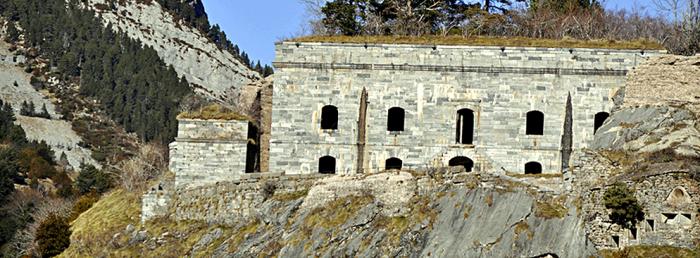Coll de Ladrones Fort

Fort du Coll de Ladrones. Source : Office de Tourisme de Canfranc
Coll de Ladrones Fort (Thieves Pass Fort) is evidence of the Spanish royal family's desire to control the kingdom's northern frontier.
Coll de Ladrones Fort (Thieves Pass Fort), the engineer Don Juan Martinez Zermeno's first piece of work, is evidence of the Spanish royal family's desire to control the kingdom's northern frontier.
It is the counterpart to Portalet Fort and was modified in the 19th century.
The construction of Coll de Ladrones Fort (Thieves Pass Fort) began during the 18th century when the Spanish royal family realised that France posed a threat to them in the Aragonese Pyrenees (French Pyrenées-Atlantiques): in 1749 the French road terminated at Peña de Aret. The fortified towns of Candanchou and Canfranc and the Especlunca tower which defended the Canfranc Valley had been abandoned. Don Juan Martinez Zermeno, Vauban's Spanish counterpart, drew the plans for Coll de Ladrones Fort during the winter of 1751, and then reinforced them with a series of fortified barracks. Work began the following year to be completed in 1758 and was supervised by Don Pascual de Navas.
The fort was designed to a horse-shoe plan. The eastern side is flanked by two half bastions on the corners. The central building consists of seven covered vaults supporting a terrace to be used as lodgings (troops, guards, sergeants, governor and officers) and to house the chapel and arms room. The building was designed to cope with a siege: it had a water tank and was heavily armed. However, it was ineffective due to its construction: poor quality materials were used and firing lines were considered excessively steep. The fort was abandoned in 1777.
Minor use was made of the site once again as a reaction to campaigns during the French Revolution and the Empire. The site, which was essential for the control of Canfranc valley, was initially reoccupied to a basic extent before being refitted from 1808 at which time Portalet, the rival fort, was linked to the hinterland by a new road between Urdo and Etsaut. It was not until 1876 that threats from France began to concern the Spanish authorities: the road constructed as a reaction to French attacks was completed. It therefore needed to be protected.
San Gil produced plans for two small forts, the road and levelling for the new fort at Coll de Ladrones. The project was approved by Royal order, by Rodriguez himself, on 4 August 1888, and work began, to be completed two years later. Of the original fort, only the northern walls and the adjoining vault were retained.
The new construction was made up of two two-storey buildings. It was capable of housing 200 troops (150 infantrymen and 50 artillerymen) and was faced in local stone. It was equipped with four guns dug into the rock, pointing north. A gallery with arrow slits, opened in the rock, led down to a battery located above the river. The attacking face of the fort was to the east, with a glacis in front of it. The entrance was protected by a caponier and flanked by a gallery with arrow slits.
Coll de Ladrones fort was used from time to time until 1961 when it was definitively abandoned and sold by the Spanish Ministry of Defence. The Fusiliers' Tower, which was contemporary to it, was constructed by order of Felipe II to defend the border passage.
The Fusiliers' Tower has been restored recently and now houses a permanent information centre for the Tunnel du Somport work sites, with an informative exhibition on this major civil engineering project.
Aspe Valley Tourist Office
Place Sarraillé 64490 Bedous
Tel: 00 33 (0)5 59 34 57 57
E-mail: aspe.tourisme@wanadoo.fr
Aragon Valley Tourism Association
Plaza Ayuntamiento, 1. 22880 Canfranc Estación (Huesca)
Tel: +34 974-372184
Fax: +34 974-372185
E-mail: atva@valledelaragon.com
Guided tours (only) from 10am to 1pm and 5pm to 7pm Monday to Saturday, and from 10am to 1pm on Sundays
Practical information
22888
Canfranc-Estación
Visite guidée (uniquement) du lundi au samedi de 10h00 à 13h00 et de 17h00 à 19h00 les dimanches de 10h00 à 13h00

